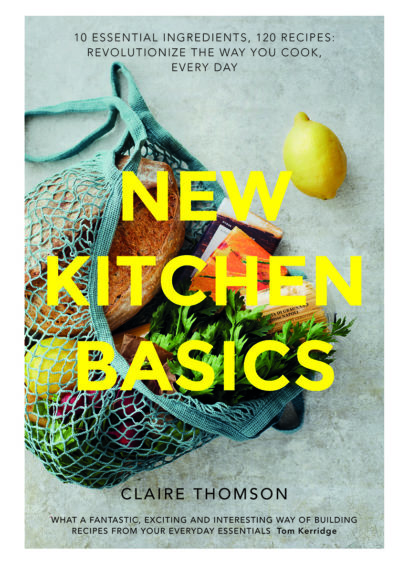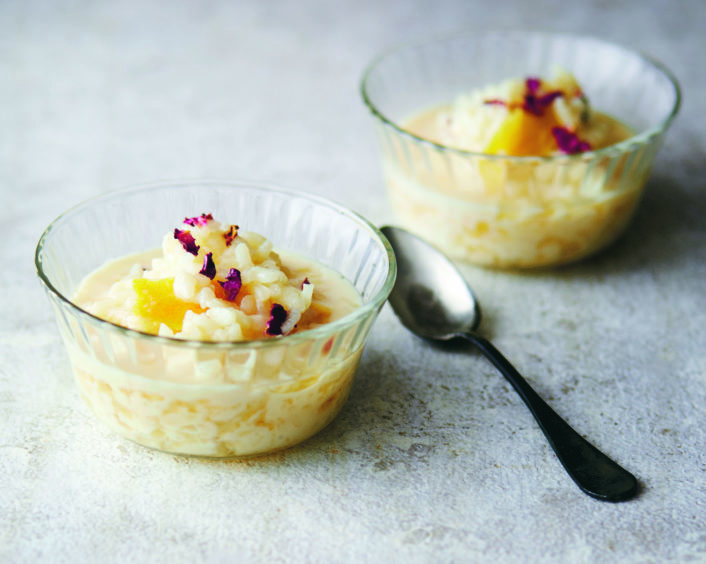
While lockdown continues, homes up and down the country will witness a similar scene each evening, as we breathe a collective sigh of despair while surveying the contents of our fridge.
The cool air washing over a few old, sprouting potatoes, a handful of wilted spinach and a month-old jar of olives, does nothing to dampen the frustration of asking, “What on earth am I going to make with this?”
But, luckily, if this nightly ritual is getting you down (or making you reach for a takeaway menu), help is at hand.
When it came to compiling her new cookbook, New Kitchen Basics, Claire Thomson knew she wanted to help home chefs add a spin to their fail-safe recipes, making good use of the everyday items which regularly top their shopping list.
Featuring 120 recipes, based around 10 essential ingredients, Claire says her book can help even the most tried-and-tested meals achieve an exciting new flavour.
“I wrote New Kitchen Basics with one question in mind – what 10 ingredients do we all have in our kitchens throughout the year?” explained Claire, who lives in Bristol with her husband and three children.
“Breaking our favourite ingredients down to just 10, then looking at them with renewed vigour, is a practical and honest way to cook.
“Sure, we all love a spag bol or chicken pie, but there are so many recipes for these and more – so what else can we cook with chicken and mince, and what new recipes can stir some excitement into home cooking?
“I also think having a framework is a great boost for the home cook, allowing for a bit of flare and innovation with new recipes and techniques.”

Each chapter is centred around one of her 10 ingredients, including chicken, eggs, salad and vegetables, potatoes, pasta and chocolate. And while it was easy to narrow down her list of must-haves, Claire admits she might have stretched to a dozen. She said: “If the book had 12 chapters I would have added rice and fruit. We eat a lot of vegetables and I could have tripled or quadrupled that particular chapter.”
Although born and raised in Zimbabwe, Claire spent many a happy summer with her grandparents in Scotland, a time she remembers fondly – especially when it comes to preparing breakfast or indulging her sweet tooth.
She said: “I spent summers in Fife throughout out my childhood. Whilst I loved my holidays, I cannot say the same for my granny’s food – she’s no longer with us, but really wasn’t a great cook.
“But one thing I have kept from her is to always, always, add a good pinch of salt to my porridge in the mornings. And I make a porridge bread with any leftovers.
“In the book, the salted peanut chocolate fudge, whilst in no way shape or form like the tablet my granny used to buy for us from the post office in Lower Largo, is pretty addictive. My kids are very happy when I make it – it’s so sweet your teeth ache, as all good fudge should be!”
As well as focusing on fresh produce, Claire advises to keep your cupboards well-stocked and focus on seasonal veg for a quick mid-week flavour boost.
She said: “Cooking in tandem with the seasons is the thriftier and more practical way to promote an imaginative diet.
“Vegetables are quick to prep and cook – be it green veg or leafy salads, cabbages or tomatoes – and using fresh veg is the mainstay of my home cooking.”
New Kitchen Basic, published by Quadrille in hardback and eBook, is out now.
Lemon & rose pudding

Rice puddings remind me of wintry Sunday lunches as a child – also, of school dinners, both sorts (although my mum’s was the superior version) baked in a Pyrex dish with dark brown and blistered skin.
I hated the skin, but loved the creamy rice, all freckled with nutmeg. This is a different sort of rice pudding, made like you would make risotto – no skin!
I like to serve it cold with lemon and rose syrup poured over the cooked rice. You could just as well serve it warm – it’s up to you.
You’ll need
- 600ml whole milk
- 1 cinnamon stick
- Large strips of zest (no pith) and juice of 1 unwaxed lemon
- Small pinch of salt
- 200g caster (superfine) sugar
- 3 tbpn rose water
- 150g risotto or short-grain rice
- 50g unsalted butter
- Dried or fresh rose petals (optional)
Method
- Put the milk with 300ml of water in a medium pan over a moderate–low heat, add the cinnamon stick, lemon zest and salt and warm for 10 minutes to allow to infuse.
- Meanwhile, in a small pan, gently heat half the sugar with the lemon juice, until the sugar has dissolved and turned syrupy. Remove from the heat, add the rose water and put to one side.
- Put the rice in a saucepan with the butter over a moderate heat and gently heat for about 2 minutes, until coated and glistening. Ladleful by ladleful, add the warm cinnamon milk mixture to the rice and cook, stirring continuously, until all the liquid is used up, the rice is tender and surrounded by a creamy sauce, about 15–20 minutes.
- Give it a rapid boil towards the end if looking too soupy, but remember it will thicken as it cools down. Remove from the heat and stir in the remaining sugar, until dissolved. Remove the lemon zest and cinnamon stick. Leave to cool.
- Pour the rice into a wide bowl. Serve cold with the syrup poured over the top and decorated with rose petals, which are also nice, if you have any.

Enjoy the convenience of having The Sunday Post delivered as a digital ePaper straight to your smartphone, tablet or computer.
Subscribe for only £5.49 a month and enjoy all the benefits of the printed paper as a digital replica.
Subscribe